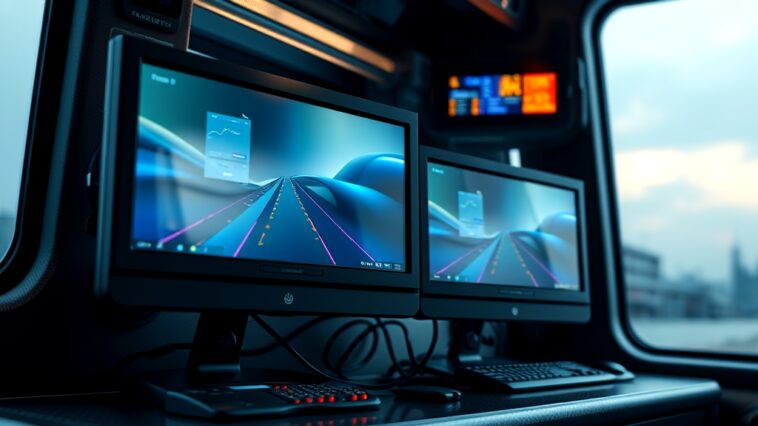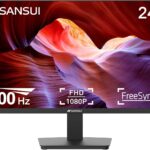Transporting computer monitors can be a daunting task, especially if you want to ensure they arrive safely at their destination. Whether you’re moving homes, shipping equipment for a trade show, or simply rearranging your office, understanding the best practices for monitor transport is essential. This guide will provide you with detailed steps, tips, and tricks on how to transport computer monitors effectively, ensuring they remain intact and functional.
Understanding the Risks of Transporting Monitors
Before diving into how to transport computer monitors, it’s crucial to understand the potential risks involved. Monitors are delicate devices with fragile components, including glass screens and internal wiring. Improper handling can lead to:
- Screen Damage: Cracks, scratches, or shattered screens can occur if not handled carefully.
- Internal Damage: Jostling during transport can affect internal components like circuit boards and connections.
- Loss of Functionality: Monitors might not function properly after being transported without adequate protection.
By taking the necessary precautions, you can significantly reduce the risk of damage during transport.
1. Preparing for Transport
Gather Necessary Supplies
Before you start the transportation process, it’s imperative to gather the right supplies:
- Original Packaging: If available, the original box and packing materials are ideal for transport.
- Bubble Wrap or Foam: For additional cushioning, especially when the original packaging isn’t available.
- Packing Tape: To secure the bubble wrap and any boxes.
- Markers: For labeling boxes to indicate fragile content.
- Moving Blankets: To protect monitors from scratches.
- Straps or Rope: If you’re transporting multiple monitors in a vehicle.
Clean Your Monitors
Before packing, ensure your monitors are clean. Use a microfiber cloth to wipe down the screens and exteriors. This not only keeps them in good condition but also prevents any dirt or debris from scratching the surface during transport.
Document Connections and Settings
Take photos or notes on how the monitors are connected to computers and peripherals. This will make it easier to set everything up again once you reach your destination.
2. Packing Your Monitors
Using the Original Box
If you have the original box, this is the safest option. Follow these steps:
- Remove All Cables: Disconnect all cables and accessories from the monitor. Store them in a separate box or bag.
- Wrap the Monitor: Use bubble wrap or foam to wrap the monitor securely. Ensure that the screen is well-protected, as this is the most vulnerable part.
- Place in the Box: Carefully place the wrapped monitor in the original box. If the box has partitions, use them to separate multiple monitors.
- Seal the Box: Use packing tape to seal the box securely.
Packing Without the Original Box
If the original box is unavailable, you can still pack your monitors safely:
- Wrap the Monitor: Use bubble wrap or foam to provide cushioning. Ensure the screen is thoroughly covered and secured with tape.
- Use a Sturdy Box: Find a sturdy box that can accommodate the monitor dimensions. Ensure it’s in good condition without any damage.
- Add Padding: Place additional padding (such as crumpled newspaper or packing peanuts) at the bottom of the box before placing the monitor inside.
- Position the Monitor: Place the monitor upright in the box, not flat, to minimize pressure on the screen.
- Fill Gaps: Fill any remaining gaps with additional padding to prevent movement during transit.
- Seal the Box: Securely tape the box shut, labeling it as fragile.
3. Transporting Monitors
Vehicle Transport
When transporting monitors in a vehicle, follow these guidelines:
- Stand the Monitors Upright: Always transport monitors vertically rather than flat to minimize the chance of damage.
- Secure the Monitors: Use straps or ropes to secure the monitors in place, preventing them from moving around.
- Cushioning: Use moving blankets to provide additional cushioning against bumps and jolts during transit.
- Avoid Extreme Temperatures: Try to avoid leaving monitors in extreme heat or cold, as this can affect their internal components.
Shipping Monitors
If you need to ship monitors, consider the following steps:
- Choose a Reliable Shipping Service: Select a reputable shipping company that handles fragile items.
- Insurance: Consider purchasing shipping insurance for valuable monitors to cover any potential loss or damage.
- Label as Fragile: Clearly mark the box as fragile on all sides to alert handlers to take extra care.
- Track Your Shipment: Use a tracking service to monitor your shipment’s progress and ensure it arrives safely.
4. Setting Up Monitors After Transport
Unpacking Monitors
Once you arrive at your destination, unpacking your monitors requires care:
- Choose a Clean, Flat Surface: Find a stable surface to unpack your monitors safely.
- Remove Padding Carefully: Gently remove any bubble wrap or foam, ensuring no debris sticks to the screen.
- Inspect for Damage: Check the monitors for any visible damage or functionality issues before connecting them.
Reconnecting Monitors
- Refer to Documentation: Use the photos or notes you took while disconnecting the monitors to reconnect them properly.
- Connect Cables: Plug in all necessary cables, ensuring they are secure.
- Power On: Turn on the monitors to test for any issues. If they function correctly, you’re good to go!
5. Additional Tips for Monitor Transport
Consider Professional Help
If you have high-value monitors or a large quantity, consider hiring professional movers who specialize in electronic equipment. They have the expertise and equipment necessary to transport monitors safely.
Monitor Insurance
If your monitors are particularly valuable, consider obtaining insurance that covers electronic equipment. This can provide peace of mind in case of unforeseen accidents during transport.
Use Monitor Bags
For frequent transport, investing in padded monitor bags can be beneficial. These bags are designed specifically for monitors and provide excellent protection against bumps and drops.
Regular Maintenance
After transporting your monitors, perform regular maintenance checks. This includes cleaning, checking for dead pixels, and ensuring all connections are secure. Regular maintenance can prolong the lifespan of your monitors.
Conclusion
Transporting computer monitors doesn’t have to be a stressful experience. By following the guidelines outlined above, you can ensure your monitors arrive at their destination safely and without any damage. Whether you’re using the original packaging or improvising with available materials, the key is to prepare thoroughly, pack carefully, and handle the monitors with care. With the right approach, you can confidently transport your monitors, knowing they will function properly when you set them up again.
Top 10 FAQs About Transporting Computer Monitors
1. How should I prepare my computer monitor for transport?
Before transporting your monitor, turn it off and unplug it. Remove any detachable cables, and if possible, use the original packaging to protect it. If you don’t have the original box, wrap the monitor in bubble wrap or thick blankets.
2. What is the best way to pack a monitor for transport?
Use a sturdy box that fits the monitor snugly. Place the monitor face-down on a soft surface, and fill any gaps with packing material to prevent movement. Ensure the box is sealed securely with packing tape.
3. Can I transport a monitor standing up?
It’s best to transport a monitor lying flat to avoid pressure on the screen, which could lead to damage. If you must transport it upright, ensure it is well-protected and stabilized to prevent tipping.
4. Are there specific temperature conditions to consider when transporting a monitor?
Yes, extreme temperatures can affect monitor performance. Avoid exposing your monitor to very hot or cold conditions. Try to keep it within a temperature range of 32°F to 104°F (0°C to 40°C).
5. How do I transport a monitor in a car?
Secure the monitor in a flat position in your vehicle, using seat belts or other restraints to prevent it from moving. Avoid placing it in the trunk where it may get jostled; place it in the cabin if possible.
6. Should I remove the stand when transporting a monitor?
Removing the stand is advisable for safer transport, especially if you have the original packaging. If you don’t have the original packaging, ensure the stand is securely attached and well-protected.
7. How do I handle a monitor during loading and unloading?
Always hold the monitor by the edges, avoiding pressure on the screen. Use two hands for better stability, and make sure to lift with your legs to prevent strain.
8. What precautions should I take when transporting a monitor long distances?
For long-distance transport, consider using a hard case for extra protection. Ensure the monitor is padded well and avoid stacking heavy items on top of it during transportation.
9. Can I use a dolly or cart to transport my monitor?
Yes, using a dolly or cart can help move heavy monitors more easily. Make sure the monitor is securely placed and balanced on the dolly to prevent tipping or falling.
10. What should I do if my monitor gets damaged during transport?
If your monitor is damaged, check for warranty coverage for repairs or replacements. Document the damage with photos and contact the manufacturer or retailer for guidance on the next steps.




